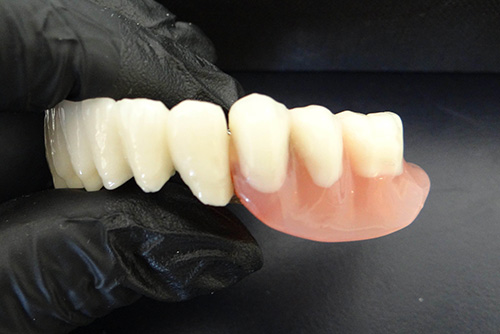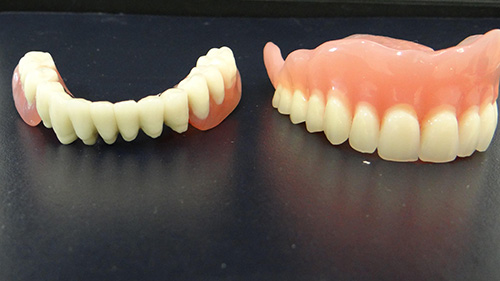PARTIAL DENTURES
What are partial dentures?
Partial dentures are types of removable dentures used when there are some natural teeth remaining. They are a prosthetic device that patients can remove by themselves.
Partial dentures replace lost tissue (teeth, tooth tissues, bone) with an aesthetically functioning unit of dental arches, improving the patients’ health and quality of life.
When to opt for partial dentures?
Partial dentures are an option in case of extensive loss of teeth and adjacent tissues (mucosal and bone defects due to bone resorption) when it is not possible to use a fixed prosthetic device or such a device is not affordable. Such dentures are supported and retained on one side by the remaining natural teeth and/or fixed prosthetic restorations (combined), and by the adjacent tissues (mucosa, jaw bone) on the other side.
What types of partial dentures are there?
There are several types of partial dentures. A partial acrylic denture consists of a prosthetic base (made of acrylic resembling the colour of the gums) which replaces the lost bone and soft tissues, false teeth which replace the missing teeth and wire clasps which help retain the denture by attaching to the remaining teeth. This type of denture is made only as a temporary solution before the final fixed prosthetic device is produced or as an immediate denture. They have poor stability and retention so they lift easily, while wires damage the natural teeth they are attached to causing tooth decay, hard tissue and gingival damage, and eventually, they can make natural teeth unstable.
These deficiencies are nowadays resolved by making combined prosthetic devices (one part of such device is fixed = such as a dental bridge or a crown which is cemented onto the remaining tooth, and the other one is mobile= a prosthesis which can be removed). Fixed and mobile parts of combined devices are connected by visible or invisible retention elements. Therefore, these devices have better retention, stability and transfer of chewing forces. They include: acrylic dentures on telescope copings, crossbars or implants (these are dentures that resemble complete acrylic dentures on the outside, but contain a fixed part under the prosthesis, such as an inner telescopic tooth crown, a crossbar or a ball which provide additional retention and stability to the denture) and a metal-base prosthesis (Wironit prosthesis). Metal-base prostheses are attached to a fixed prosthetic device (e.g. a dental bridge) by cast clasps (which encircle the supporting tooth or its tooth crown and are cast in one piece together with a prosthetic base) or special invisible ties (e.g. anchors, balls, ). Such partial dentures have a more complex structure because of their retention elements. Apart from providing additional retention, stability and transfer of chewing forces, these elements can also be completely invisible. Such prosthetic devices thus resemble a complete dental arch which makes them functionally and aesthetically superior to classical acrylic partial dentures. The advantage of making a metal-based partial denture is its resistance to fractures and a thin, lightweight and reduced prosthetic base surface.
What is the procedure of making partial dentures and how long does it take?
The procedure of making partial dentures depends on the type of dentures.
Making acrylic partial dentures with wire clasps as a temporary solution or an immediate denture (complete or partial) is quick (if necessary, it can be made in just one day). Immediate dentures are made in the dental laboratory based on the impressions taken right before the tooth extraction, which makes them imprecise. However, they provide the patient with the necessary teeth and an acceptable solution while waiting for the final removable, combined or fixed prosthetic device.
Making combined prosthetic devices requires several phases and, thus, several visits to the office. Making such devices lasts about 3 weeks. The fixed part is made first, and then the removable one.
Steps of making a removable part of partial dentures:
- After the initial examination and diagnostics, we primarily determine whether you are viable for partial dentures, followed by the arrangement about the future work and then a work plan, appointment schedule and production timeline are organised
- The next step is taking impressions, determining jaw relation and bite height. Based on the impressions and all the defined parameters, a technician makes the dentures in a dental laboratory.
- During the fitting of dentures, aesthetics and the functionality are checked. If everything is satisfactory, the technician finishes the production in the dental laboratory.
- When being presented with the partial dentures the patient is advised on chewing, speech, denture care and oral hygiene.
- A follow-up examination and possible correction of dentures takes place.
What to think about before making partial dentures?
If you are considering partial dentures you should know they are a prosthetic replacement which:
– enables the regaining of lost chewing function, improves speech, contributes to enhanced aesthetics of the lower third of the face, and thus improves the quality of life;
– Very often after a short period of wearing dentures they may cause a feeling of irritation on the mucosa in some places and wearing them may cause pain or a lifting of dentures while chewing. These problems usually occur due to setting the dentures onto the mucosa or having premature contact on some position of the bite. Such imperfections can easily be fixed by a dentist correcting the dentures. Therefore, it is important not to skip follow-up examinations. Wearing dentures for at least two hours prior to visiting the dentist is recommended since it allows for exact identification of sore spots on the mucosa.
– if not fixed to a surface but achieves stability by its direct suction to the mucosa and by using wire clasps, stability and retention of these dentures will be poor. It might uplift and clasps might move causing damage to natural teeth which they are attached to, tooth decay and damage to tooth tissues and gingiva. Finally, clasps might make those teeth unstable. Also, their visibility is unaesthetic. Dentures require getting used to and it is a process which varies in length with different patients.
– if combined (has both fixed and removable parts) there are no visible retentions and we get the impression of the whole, healthy and beautiful dental arch, which is well retained and stable, functioning almost as good as a fixed prosthetic device.
What to do after making partial dentures?
After you receive your complete dentures you should be patient in getting used to them; in the beginning they will feel like a foreign object in your mouth and it takes time to learn how to eat and speak with them.
Very often after a short period of wearing dentures they may cause a feeling of irritation on the mucosa in some places and wearing them may cause pain or a lifting of dentures while chewing. These problems usually occur due to setting the dentures onto the mucosa or having premature contact on some position of the bite. Such imperfections can easily be fixed by a dentist correcting the dentures. Therefore, it is important not to skip follow-up examinations. Wearing dentures for at least two hours prior to visiting the dentist is recommended since it allows for exact identification of sore spots on the mucosa.
Regular check-ups are also important, at least twice a year. It is important to monitor your oral health and the condition of the dentures. Due to gradual bone resorption under the dentures they can, in time, become unstable (“too big“) and fall out. They need relining (with acrylic material) to improve their stability.
The mucosa under the dentures, especially in women, can develop fungal (Candida albicans) inflammation and inadequate denture hygiene can lead to mucosal inflammation and bad breath.
Dentures need to be brushed with toothpaste and a toothbrush after every meal and submerged in a glass with solution of denture disinfectant (denture disinfectant tablets) once a day. They should be submerged for at least 15 minutes and then thoroughly rinsed with water (or in accordance with the instructions by the manufacturer).
If the dentures are not in your mouth, they should be kept in a glass of water, because of the material they are made of.
Dentures should be handled carefully to avoid breaking and bending. Dentures are most commonly damaged when out of the mouth, as a consequence of falling while being cleaned.
Damages to the dentures base and/or teeth can easily be repaired in a dentist’s office and/or dental laboratory.
Why choose to make partial dentures in OUR practice?
- We have 17 years of experience in producing prosthetic replacements.
- We try to make you feel comfortable and relaxed in our practice, without any fear.
- We respect your wishes relating to the health and beauty of your future smile and try to fulfil them completely.
- Our goal is to make your smile functional and aesthetically perfect.
- Your partial dentures will be produced in a renowned dental laboratory and will be of outstanding quality and aesthetics.
- The work in your mouth will be painless and safe, we will do our best to make it as comfortable as possible and our service as good.
- Your “before and after“ photos of the partial dentures will be preserved.
- At any moment we are available to you for advice and consultation via mobile phone, e-mail and social media.
- We try to keep our appointments.
- You can pay in cash, but also in interest free instalments: American Express up to 12 instalments, Diners up to 6 instalments, Erste & Steiermärkische bank Maestro and MasterCard up to 12 instalments.
- There is free parking in front of the practice.
If we meet your criteria, feel free to contact us and make an appointment.
If these pages do not provide you with an answer to your question on partial dentures, dental health and dental services, feel free to contact us.
We are at your disposal!
| Radno vrijeme
PON, SRI, PET 9:00-16:00
UTO, ČET 13:30-20:30
☎ +385(0)1 4822 137








